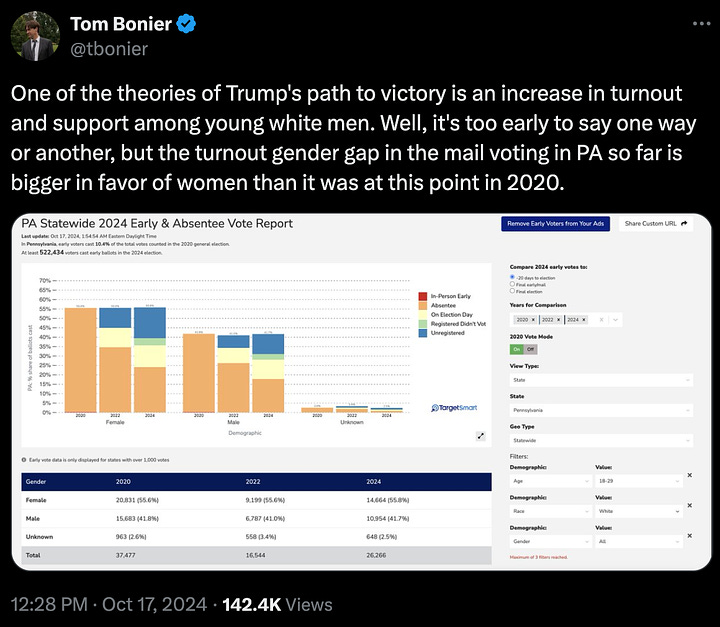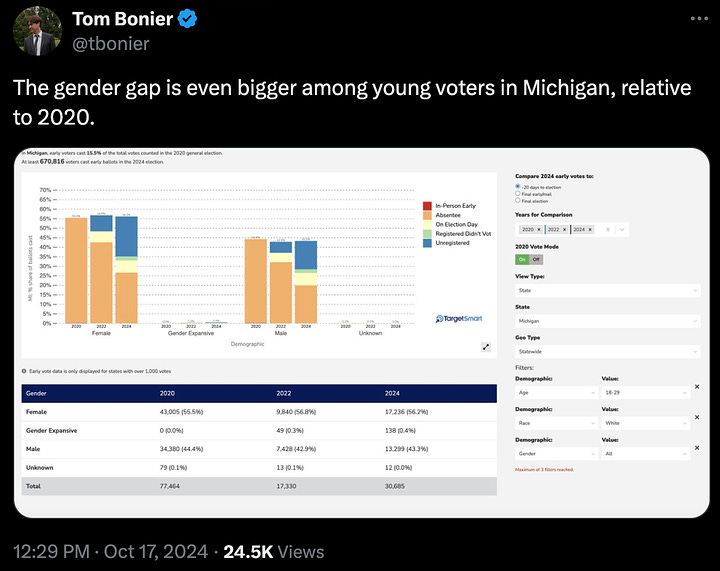In a wide-ranging interview on MeidasTouch, host Ben Meiselas was joined by data experts Simon Rosenberg of Hopium Chronicles and Tom Bonier, CEO of TargetSmart, to unpack what early election data is telling us about the 2024 race. With early voting well underway in critical battleground states, Rosenberg and Bonier provided insights into key trends and shifts that could shape the outcome of the election. While it’s still early, the data already reveals some significant surprises, particularly concerning turnout and demographic patterns.
Surprising Gender Gap Trends
One of the most striking takeaways from the early data comes from the analysis of voting patterns in Pennsylvania and Michigan. Bonier noted a larger-than-expected gender gap in early voting, with women making up an even bigger share of the vote than they did at the same point in the 2020 election. "We expected to see a narrowing of the gap this time, particularly among younger men, because of concerted Republican efforts to target these voters," Bonier explained. "But instead, the gap has widened."


This gender gap is especially significant among younger voters, where women are turning out in larger numbers relative to men, a trend Bonier links to the Supreme Court’s Dobbs decision, which overturned Roe v. Wade. "Young women have been the most energized demographic in the post-Dobbs political environment," Bonier said, adding that Republican attempts to attract young male voters through figures like Joe Rogan and events like UFC fights don’t appear to be translating into a noticeable impact on early turnout.
Republican Early Voting Efforts Falling Short
Another key theme of the interview was the Republican Party’s attempts to improve early voting numbers, a tactic they notoriously struggled with in 2020. Following Donald Trump’s unfounded claims that mail-in voting was rife with fraud, many Republican voters were reluctant to vote early or by mail in 2020, and the party faced substantial deficits in early voting. The GOP vowed to fix this tactical error in 2024, but the early data suggests that these efforts have not borne fruit.
Bonier explained, “We anticipated seeing Republicans account for a much larger share of the early vote this time around, especially given the emphasis they’ve placed on correcting their mistakes from 2020. But so far, in key states like Pennsylvania and Michigan, that just isn’t happening. Democrats continue to hold the same large early voting advantages they had in 2020.”
In Pennsylvania, for instance, early voting data shows a 31-point lead for Democrats, a margin nearly identical to what was seen in 2020. “Where are the Republican efforts? We’re not seeing them materialize in the data,” Bonier remarked.
High Turnout Signals Strong Voter Engagement
Beyond the demographic shifts and partisan dynamics, both Rosenberg and Bonier stressed the importance of overall turnout trends. According to Bonier, all signs point to high turnout in 2024, similar to what was observed in the last two election cycles. Early voting records are being shattered in states like Georgia, where the first two days of in-person voting saw unprecedented numbers.
This high level of voter engagement, particularly in key Democratic constituencies, suggests that Republicans may face an uphill battle on Election Day. Bonier highlighted the high turnout among Black voters, particularly older Black women in Michigan, where Democrats have traditionally held strong. "It’s not just about the early vote. Voter registration efforts in these communities have been off the charts, and that enthusiasm is showing up in the early vote," he said.
Debunking Republican Spin
A notable part of the conversation centered on how Republicans are spinning the early voting data, particularly in Georgia. Bonier pointed out that despite claims from some on the right that Republicans are performing well in early voting, the reality is that the data tells a different story. While some rural Republican areas may show a higher percentage of returned ballots, Bonier emphasized that raw vote totals are what matter. In Democratic strongholds like Fulton and DeKalb counties, voter turnout is far outpacing those smaller Republican areas.
Simon Rosenberg added that the lack of Republican spin on early voting is a telling sign. "If Republicans had good news to share about early voting, they’d be shouting it from the rooftops," he said. "Instead, we’re seeing them talk about betting markets and crypto-based “prediction” models, which is pure spin because they don’t have the data to back up their claims."
The Importance of Early Voting
Both Rosenberg and Bonier ended the conversation by urging voters to take advantage of early voting. "Voting early is a critical piece of the puzzle," said Rosenberg. "When you vote early, you allow campaigns to shift resources to lower-propensity voters, which increases overall turnout." He also noted that Democrats performed exceptionally well in 2022 thanks to their strong early voting efforts, which built significant margins heading into Election Day.
Bonier agreed, emphasizing the role early voting plays in creating a "firewall" for Democrats. "We’re seeing those firewalls build in states like Pennsylvania and Michigan. While it’s important to recognize that nothing is guaranteed, those early voting margins give Democrats a cushion going into Election Day, which Republicans will struggle to overcome."
As the early voting data continues to roll in, Rosenberg and Bonier remain optimistic about Democratic prospects in 2024, but they stress that high turnout and early voting are essential for maintaining that edge. The November election, they noted, could technically be won in October if Democrats continue to vote in large numbers ahead of Election Day.
Watch the full interview with Simon and Tom ad-free exclusively here on Substack! If you appreciate this data and analysis, please consider becoming a paid member of Meidas+ today!
Visit Hopium Chronicles to read more from Simon.
Visit TargetSmart to see Tom’s latest data.
























Early Election Data Points to Key Trends in 2024: What the Numbers Tell Us So Far